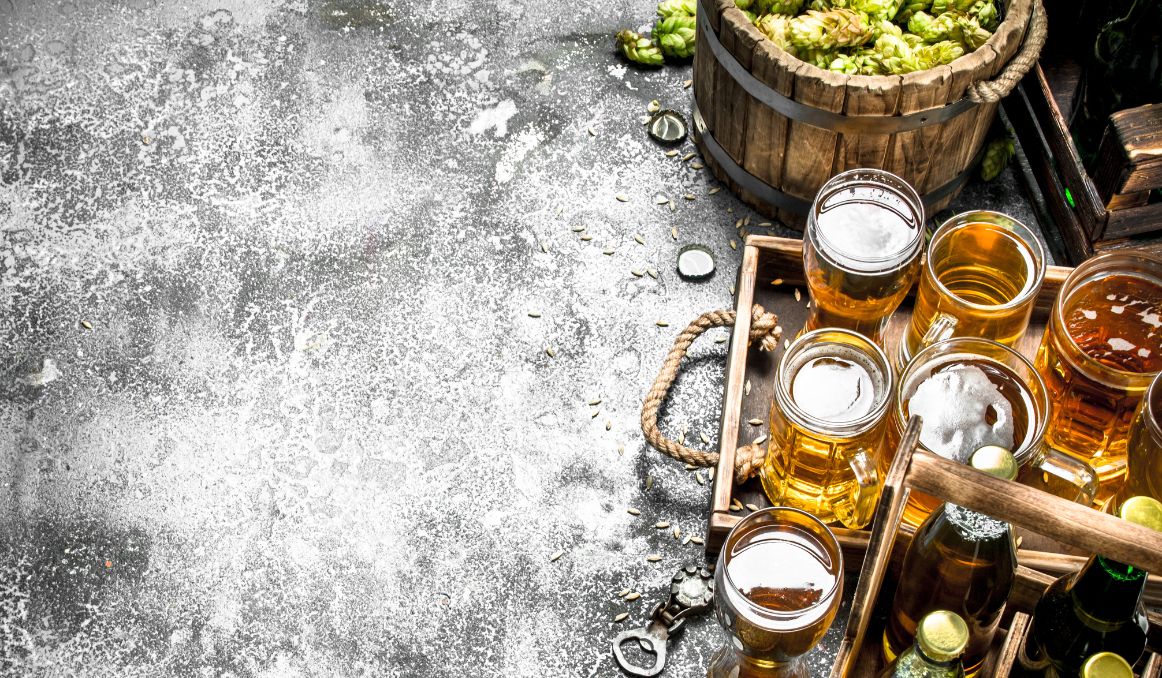What Is a Beer Adjunct? Meaning and Examples
Even if you’ve never heard of a beer adjunct or have no idea what a beer adjunct meaning could be, chances are great that if you love beer, you’ve had beer adjuncts.
In fact, beer adjuncts are easily as old as beer itself.
So, what is a beer adjunct?

Beer Adjunct Meaning
The dictionary definition of an adjunct is an ingredient added to a recipe that is not essential to its production.
The necessary ingredients in beer are malted grain, water, hops, and yeast. Interestingly, yeast has not always been considered an essential ingredient because for millennia, brewers did not add yeast; beer naturally fermented when left out to the elements.
Today, anything outside of those four ingredients is considered an adjunct, including an additional grain.
So, while your primary grain may be malted barley, if you add oats or wheat, those grains would be considered adjuncts.
Typically, adjuncts are also considered fermentable sugars, which is not too much of a stretch considering anything with carbohydrates could qualify as a fermentable sugar.
But the adjunct does not have to be fermentable. It can be an unfermentable sugar like lactose, or it could be an herb like cilantro.
History of Beer Adjuncts
The purpose of adjuncts has always been to play around with flavor, aroma, and texture, or mouthfeel.
Realize that once upon a time, there were no herbs in beer.
Beer was simply a toasted grain boiled in water and left out to ferment.
But the end result was mighty sweet as those malted grains have a ton of fermentable sugars and the yeast attracted to the wort had a relatively low alcohol tolerance, so the beer would be a sweet bread-like beverage with an ABV around 1%.
So women, who were the primary brewers at first, started experimenting with ways to cut the sweetness down and add a bit of bitterness, and they created a mixture of herbs they called “gruit” which got the job done.
It was only about 500 years ago that hops were adopted as the universal herb in beer to get that same job done.
Then there’s the issue of bacteria in beer, which was once a foregone conclusion. Brewers could not help that the common bacteria, Lactobaccilus, would creep into the brew alongside wild brewer’s yeast, creating a sour effect in the beverage.
Again, it was not always an adjunct. It was just par for the course with brewing.
Now, brewers will add it intentionally to create that sour effect, so it would be considered an adjunct.
But brewers experimented of course with several other adjuncts, either to make up for grain shortages, to increase or decrease sweetness, or simply to play with flavors.
Today, the primary purpose of adjuncts in beer is just that, exploring our options with flavor and texture.
You can find beer adjuncts that range the gamut from strawberries to oysters, and all for the fun of brewing. And they can be mash adjuncts, meaning they are added to the mash-in, or kettle adjuncts, meaning they are added after the wort is boiled.
Examples of Beer Adjuncts

Bacteria and Yeast
Remember this was the original and unintentional beer adjunct. Today you can find beer with Lactobacillus or Pediococcus to create a sour effect in beer. Also, you will find brewers adding experimental wild yeasts from local regions to play around with the fermentation process.
Grains
After yeast and bacteria, grains are probably the most common adjuncts added to beer. In addition to the barley malt, brewers may add oats, wheat, corn, rice, and even rye. With the rise of the gluten free movement, some brewers are even playing with grains like quinoa to add to their wort to enhance flavor and texture without the gluten.
Fermentable and Unfermentable Sugars
Sometimes, fermentable sugars are added to increase the alcohol content. Remember, the more sugar the yeast has to consume, the more alcohol it can produce as a waste product. Brewers may add cane sugar or molasses during the mash in to increase alcohol volume. Conversely, brewers may add an unfermentable sugar like lactose after fermentation in order to add a level of sweetness to the beer.
Chocolate and Vanilla
We often find chocolates and vanillas in porters and stouts, beers that already lean in that direction. You’ll even find some beers have cacao beans to make a chocolate beer, while some of the same flavors can come from chocolate chips, bars, or syrups.
Vanilla can be added using its whole bean or with a syrup.
Coffee
Another favorite of porter and stout brewers is the coffee bean. It goes well with the dark, roasted flavors and can be added to the wort either during mash-in or after the boil.
Herbs and Spices
We already know about hops, but many other herbs are introduced to beer as well. Typically herbs and spices like cilantro, mint, nutmeg, ginger, or allspice will be added after the boil so the flavor remains strong without becoming bitter.
Fruits and Vegetables
The rise of light, wheat, summer beers has led to a proliferation of fruit and vegetable beers. Think of flavors like watermelon and citrus, for example. Fruit will contribute flavor, color, texture, and of course more sugar, which means a higher ABV overall.
Out of the Ordinary
Then there are the crazy adjuncts like fried chicken (yes, fried chicken) and shrimp or squid ink. Seriously, if you can think of it, it has likely been added to beer as an adjunct. Brewers love to play around with their brew, creating interesting pairings to go with a food menu or just to have fun and offer something new, and a bit wild, to their customers.
In the end, when it comes to adjuncts, it’s all about a willingness to be bold and daring.
So have fun with it and see what happens.
Who knows? Maybe you’ll hit on the next big beer adjunct craze.
Cheers!
Passionate about the beer and/or wine making process? So are we! If you’re interested in finding out how you can use our technology to control fermentation and monitor your yeast, save work hours and improve the cost-efficiency of your business, drop us a line at [email protected] or check out our product pages:
- Oculyze BB 2.0 (Better Brewing) Yeast Cell Counter App + Hardware
- Oculyze FW (Fermentation Wine) Yeast Cell Counter App + Hardware
Also, you can now get access to a fully functional demo account to test your yeast via our Web App. Completely free of charge and with no commitment to purchase.
Sources:
- https://www.fullcirclebrewing.com/post/what-is-an-adjunct-in-brewing
- https://www.thespruceeats.com/beer-adjuncts-guide-353147
Stay on top on important fermentation insights – subscribe to our monthly newsletter and receive a hand-picked selection of our most relevant articles straight to your inbox.
Never miss a beat and get real time updates with a new article each workday by subscribing our social media channels.
Instagram | Facebook | Twitter | YouTube


